Plant your cut flower garden so that you can have ample blooms for flower arrangements all season long, even if you live in zone 3. Do you love to have flower arrangements but hesitate to cut flowers from your beautiful flower beds? Then a flower cutting garden is for you!
The reason for your reluctance when cutting inside of the regular flower beds is understandable. We all want to have picture perfect ornamental flower beds, but once you start cutting large handfuls of flowers for arrangements, the aesthetics are ruined. A cut flower garden solves the problem. It’s an area created solely for growing and harvesting flowers to bring indoors for table center pieces, vase arrangements, and for gifting to friends and neighbors.
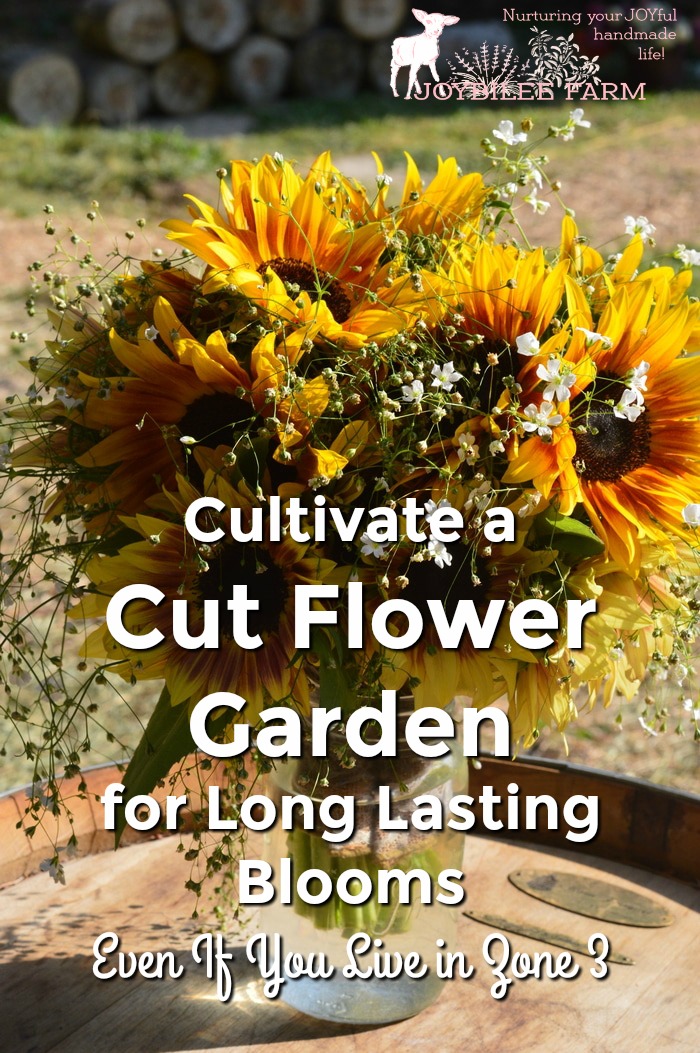
Flowers benefit the veggie garden
It took me a long time to plant flowers in my vegetable garden. Sure a Johnny Jump Up here and there or an echinacea found it’s way in the border but I didn’t intentionally plant flowers because I thought of my garden as a food garden. There was no room for flowers, or so I thought. When my children were toddlers, my father scolded me, the first year I planted a veggie garden, because well, you can buy veggies at the store. “You should be planting flowers,” he said. And that simple exchange imprinted itself on my mind, so that flowers and veggies were different gardens and I thought I couldn’t have both. Since I only have so much energy and I viewed medicinal herbs as an integral part of my vegetable garden, I didn’t give flowers a thought, until last year. When my daughter decided she was having an outdoor wedding at the farm. Suddenly flowers became very important. We needed flowers as a screen to hide some unsightly parts of the farm, flowers for table arrangements, flowers for wedding bouquets and corsages, and flowers to grace the house for the guests that we hosted.
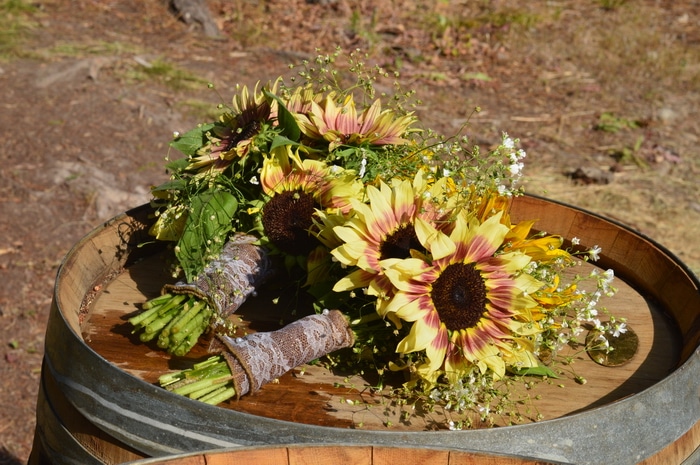
I found out that I love having fresh flowers to cut every week and bring to my dining room table. And I found that the native bees and the honey bees, were prolific on my flowers. There were more flowers in the cutting garden than I could possibly bring indoors and those flowers bloomed from July to the end of October, through the first few frosts. And until the killing frost, they were covered in bees, butterflies, and even a few hummingbirds. Planting flowers for a cutting garden meant we spent more time out doors, admiring the abundant blooms, observing the pollinator activity around the flowers, and just enjoying the garden.
This garden was planned to provide cut flowers. It wasn’t a decorative garden to please the homeowner’s association. But it gives a whole new meaning to the term “utilitarian”, because it was beautiful too. The joy of a cutting garden is that as soon as you cut a stem to create a bouquet, a new stem or even two or three grow to replace the one you cut, giving a perpetual harvest of flowers over a long season.
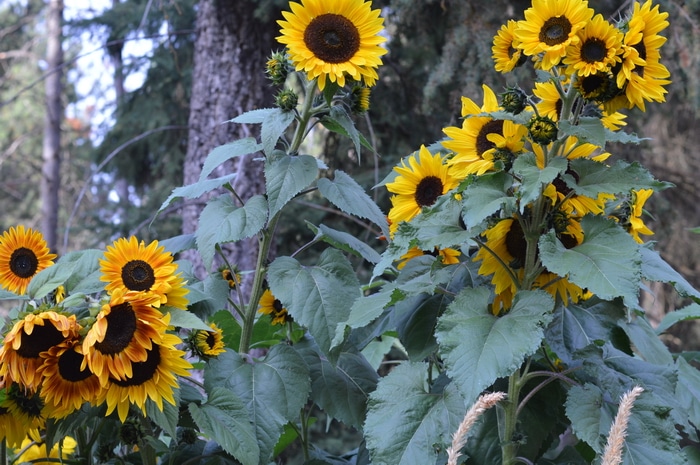
Create the garden bed area
Here’s how to create your own flower cutting garden. This cut flower garden will be planted in rows, so you will need to create a weed and grass free garden bed that has loose, pliable soil, that is rich in compost or manure. This may require turf removal if you are starting from scratch. If you have the time to plan ahead in the fall, select your area and lay several sections of heavy cardboard and mulch over the bed. In the spring, the turf will have died and you will have a weed and grass free area for planting seeds and starts.
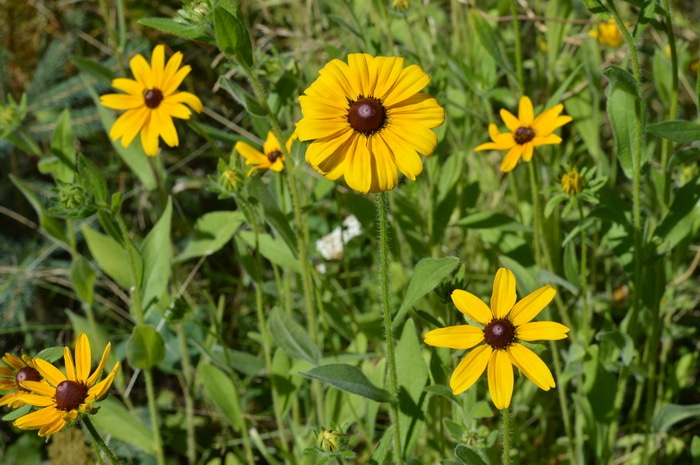
Rows are important for this version of the cut flower garden because you will be treating this just like a vegetable garden area with regular harvest times. Start with a 10 x 10 foot area and plant the rows three feet apart. This allows you to move easily throughout and around the garden while harvesting. As you are putting things together and making notes, do not plan for color coordination or companion planting. That will only hinder your willingness to cut those blooms when they are ready for “harvest.” If you start making it look too pretty, you’ll hesitate to bring your harvest indoors. But keep in mind that each time you cut a bloom, two or three more blooms will grow to take it’s place. It’s a win-win for you and for the pollinators.
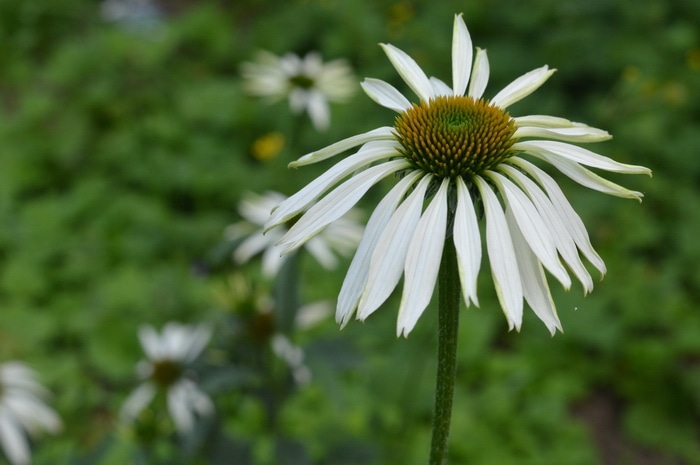
Annuals or perennials?
There is room for both kinds of flowers in your cutting garden. Just remember to keep annuals planted in one row and perennials in another row. Keeping them separated will help with bed cultivation after the annuals are spent. The perennials will spread out in the next year, once the annual flowers are removed, and you’ll have bigger harvests from them in the second and third years after planting.
All flowers will benefit from regular cuttings. Instead of deadheading, you will be bringing blooms indoors. This helps the plants to continue blooming – and many will bloom through the first frosts until the killing frosts.

Lay out the cutting garden
There are only a few rules to keep in mind as you plan your specialty cut flower garden.
- The bed should be orientated north to south in full sun
- Place the tallest plants on the north end of the bed so they will not shade the shorter blooms.
- Arrange your seed packets, or plant starts by bloom height before you start planting. Start at the south end with the shortest flowers and work your way to the tallest. Remember, color coordination is not important.
- Place perennials in their own row, do not intermix them with the annuals.
- Mark your seed rows with plant markers and include the date you sowed the seeds.
- Add row covers to speed germination (optional, depending on the time of year you are planting)
- Water the entire garden and make sure it receives about one inch of water per week during the growing season.
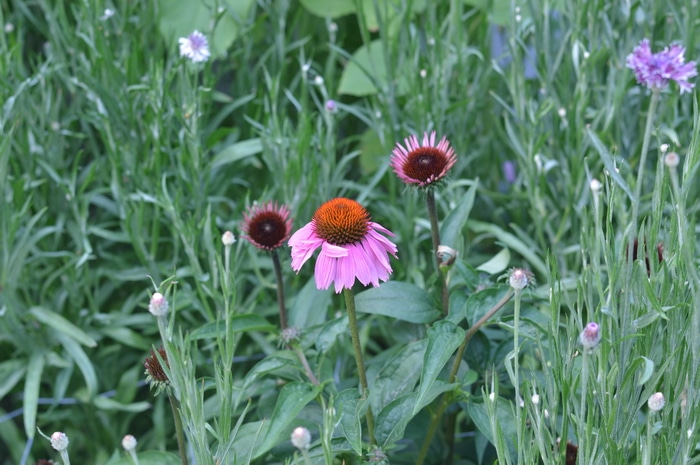
List of flowers for a zone 3 cutting garden
- Rudbeckia – plant as early as you’d plant peas in your area. Long-booming lasts until the first frost. 18 to 32-inch stems.
- Zinnia – easy to grow annual, bring large colorful blooms. Start seeds directly in the garden, 75 to 90 days to harvest
- Cosmos – blooms reach from 3 to 4 feet tall in ranges from white to pink, to purple. 90 to 120 days to harvest
- Marigold – choose tall varieties like Vanilla or Mr. Majestic, 50 to 70 days to harvest
- Scabiosa – comes in a wide range of colors including black, blue, yellow, pink and red. 80 to 100 days to harvest, plant height 24 to 36 inches
- Ammi – annual (flowering carrot) 60 to 95 days to harvest
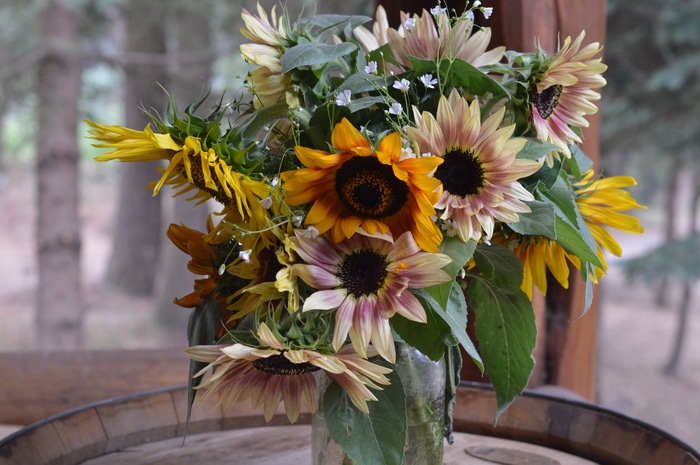
- Sunflower – sow directly in the garden. Choose Strawberry Blonde or Firecracker varieties, which are quick to blossom, branching, and pollen free. Will bloom from 50 days to killing frost.
- Calendula – direct sow from seed, 55 days to harvest. Used medicinally for skin care.
- Ageratum – also know as floss flower, these blooms attract bees and butterflies. 24 to 30 inches tall, 80 to 100 days to harvest
- Sweet Peas – Presoak seed 24 hours before planting out to increase germination. 74-90 days to harvest
- Echinacea (perennial) Attracts butterflies, grows 18 to 30 inches tall depending on the variety.
- Poppy direct sow in the garden. Varieties range from 8 to 16 inches tall. 55-60 days to harvest
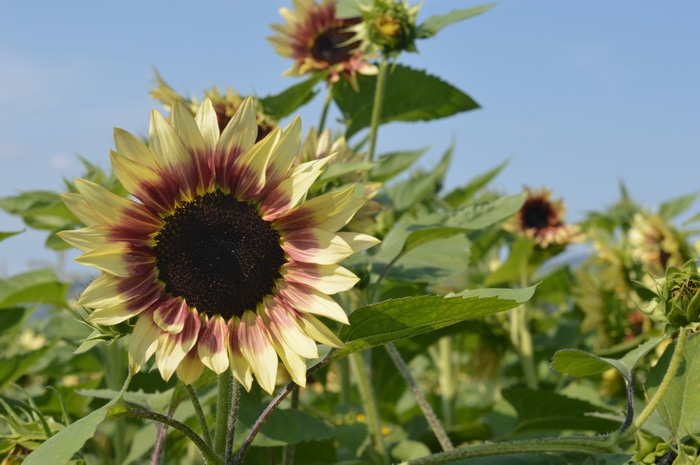
Consider these Filler Flowers
- Bachelor Buttons – This easy to grow blue, white, or pink old-fashioned flower gets 2 to 3 feet tall.
- Baby’s Breath – averages 18 to 24 inches tall. 45 to 50 days to harvest.
- Amaranthus – 80 to 100 days to harvest
- Ammobium – white blooms are beautiful as cut flowers and easy to dry, stalks reach 20 to 26 inches tall. Harvest in 70 to 80 days.
- Coleus – grown for leaves, 45 days to harvest
- Monarda (perennial) attracts hummingbirds and bees. Grows to 4 foot tall.
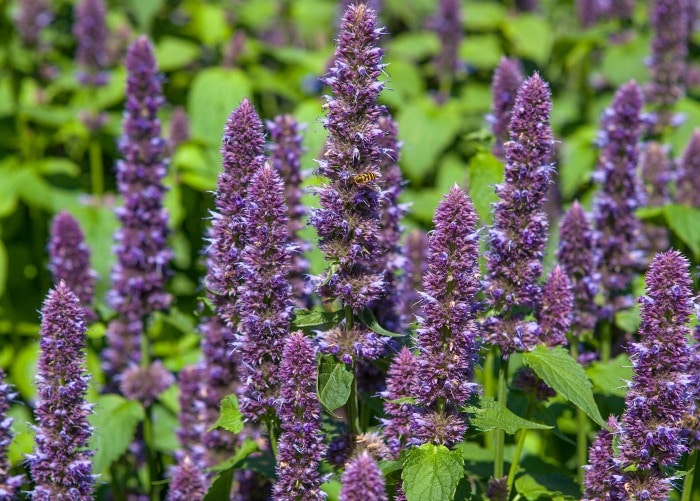
- Anise Hyssop (perennial) attracts bees and pollinators, reaches 24 to 36 inches tall. Harvest in 75-80 days
- Nasturtium – Direct sowing to field or container is recommended. 55 to 65 days to harvest
- Nigella – Direct sowing to field or container is recommended. 63 to 84 days to harvest
- Yarrow (perennial) This healing plant can be used for flower arrangements or to stop bleeding. 90 to 110 days to harvest
This list consists of flowers that bloom in the range of 55 to 80 days but many go beyond that and are ones that I’ve already grown successfully here in my zone 3 garden. Start them indoors to be ready for early spring planting. You can set many of these out when there is still frost (Rudbeckia for instance) and they will bloom in August here in BC, even though they are 100 days to bloom.
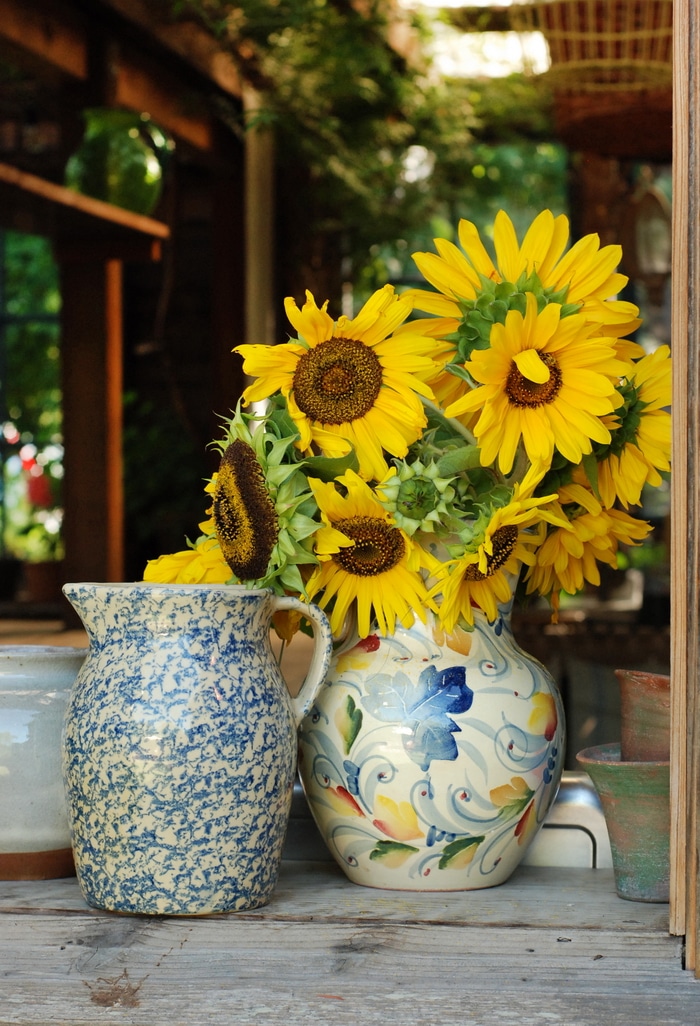
How to arrange garden flowers to get more bouquets
Now that you have some ideas for what to grow in your flower cutting garden, learn to arrange flowers and spread the cheerful beauty and fragrance throughout your home. Flowers such as sunflowers, roses, dahlias, brown-eyed Susan, purple coneflowers, and other large blooms work well as the focal flowers. You’ll need 12 to 15 blooms depending on their size. Filler flowers can be baby’s breath, anise hyssop, daisy, aster, pansy, everlastings, and many other daintier blooms. Fill in with herbs and other greenery like ferns or evergreens to make a full, showy table centerpiece or smaller vase arrangement. Don’t overlook native plants for greenery like oregon grape, with its holly-like leaves or willow with it’s twisted stems. Get instructions in this article DIY Floral Arrangements.
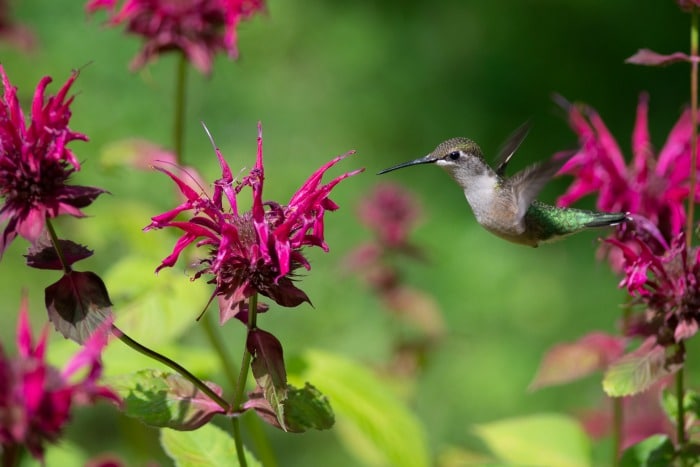
Beyond the cut flowers
Cut flower gardens provide more than just blooms to bring indoors to decorate your home. They also attract pollinators to your garden, increase your garden’s biodiversity, support endangered insects and hummingbirds, and increase the richness of the beneficial insects that come to your yard. Your cut flower garden can also reduce the pest problems in your vegetable garden by attracting predatory insects like lady bugs, lacewings, and predatory wasps. Consider creating a small cutting garden in your yard for aesthetics and for the pollinators. You’ll enjoy your garden longer when you add flowers.
Back to you
Which cutting flowers will you add to your garden this year?



Leave a Reply